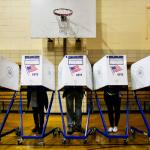New Poll Tries to Understand Blue-Collar Swing Voters.

‘Just a fantasy’ |
|
Political pundits often talk about swing voters as if they were upscale suburbanites, like “soccer moms” or “office-park dads.” And some are. But many are blue-collar. They are the successors to the so-called Reagan Democrats, who let Republicans win the White House in the 1980s and Democrats retake it in the 1990s. |
|
This century, blue-collar swing voters helped elect Barack Obama twice, Donald Trump once and Joe Biden in 2020. They have also played a deciding role in congressional and state elections, including in Virginia last week. |
|
In the current polarized political atmosphere, many college graduates follow politics obsessively — almost as if it were a sport — and identify with one of the two parties. Many working-class voters, on the other hand, vote for both parties and sit out some elections. |
|
Figuring out what moves these swing voters is a crucial question in American politics. It has become an urgent question for the Democratic Party, which is struggling to win working-class votes in many places, including some Asian and Latino communities. |
|
This morning, a creative new poll exploring these issues is being released. It asks working-class respondents — defined as people without a bachelor’s degree — to choose between two hypothetical candidates. The candidates are described both personally (their gender, race and job category) and politically (including a sound bite in which they talk about their views). |
|
A central conclusion is that infrequent voters are not a huge Democratic constituency just waiting to be inspired by a sufficiently progressive economic message. “That’s just a fantasy,” Bhaskar Sunkara, the founding editor of Jacobin, a socialist magazine and one of the poll’s sponsors, told me, “and it’s a fantasy we ourselves have engaged in.” (In fairness, numerous other people — including Trump and, well, me — have believed that same misplaced idea.) |
|
The poll instead finds that working-class swing voters hold a swirl of progressive and conservative views. “To mobilize these voters will take a lot of grass-roots organizing efforts, particularly more labor-union-centered organizing,” Sunkara said. “There is no simple programmatic solution” — for either party. |
|
Below, I walk through themes from the poll, focusing on those respondents who said they did not lean toward either party. About 33 percent of them voted for Trump last year and 22 percent voted for Biden, with the remaining voting for a third party or not voting. |
|
YouGov, a large nonpartisan pollster, conducted the poll, in collaboration with Jacobin and the Center for Working-Class Politics, a new progressive group. |
Politics isn’t just issues |
|
Nothing produced a more positive response from poll respondents than hearing that a candidate was a small-business owner. It offered a bigger lift than any political position or demographic feature, and it was popular across Black, Latino and white respondents. |
|
Voters also had positive feelings about candidates who were listed as being teachers, veterans or construction workers. Lawyers fared less well, and Fortune 500 C.E.O.s did worst of all. |
|
|
It’s a reminder that big business and small business have very different images — and that Trump’s victory depended on selling himself as a brash entrepreneur rather than a bland corporate manager like Mitt Romney. |
Race is undeniably vexing |
|
Many Black working-class swing voters are attracted to candidates who focus on racial justice — by promising to “end systemic racism,” for example. Many white working-class swing voters are turned off by these same positions. There is no simple answer on race for the Democratic Party, given that it must attract a multiracial coalition to win. |
|
But the political costs of a campaign message focused on ethnic identity seem significantly larger than the benefits, Sunkara said. Among five different candidate sound bites presented to respondents, the worst-performing was one that the pollsters internally described as “woke moderate.” Its first sentence sounds like something out of a corporate mission statement: |
|
Our unity is our strength, and our diversity is our power. But for too long, special interests have blocked critical progress in addressing systemic racism, climate change, and access to affordable health care. We need creative leaders who will fight for our values, listen to the experts, and make real change happen. |
Populism is popular |
|
The second best-performing sound bite was one that pollsters internally referred to as “Republican.” It warned that “freedom is under threat from radical socialists, arrogant liberals and dangerous foreign influences.” |
|
Yet the most successful sound bite was the “progressive populist” one. It was as pugnacious as the Republican entry, albeit with different targets: |
|
This country belongs to all of us, not just the superrich. But for years, politicians in Washington have turned their backs on people who work for a living. We need tough leaders who won’t give in to the millionaires and the lobbyists, but will fight for good jobs, good wages, and guaranteed health care for every single American. |
|
Populism has its limits |
|
Working-class swing voters tend to favor generous versions of Medicare, Social Security and other universal government benefits, polls consistently show. But they also responded positively in this poll to candidates promising vaguely to “cut government spending.” |
|
And while Democratic-leaning working-class voters liked a “Medicare for all” message, swing working-class voters preferred candidates who instead promise to “increase access to affordable health care.” |
|
Americans are mostly progressive on economics, but Democrats can still run too far left on these issues. |
|
|
You can read the full poll results here. (If you do, note that the beginning of the report focuses on a Democratic-leaning group of working-class voters — who are relevant to primary elections — rather than the swing voters who have been my focus.) |



